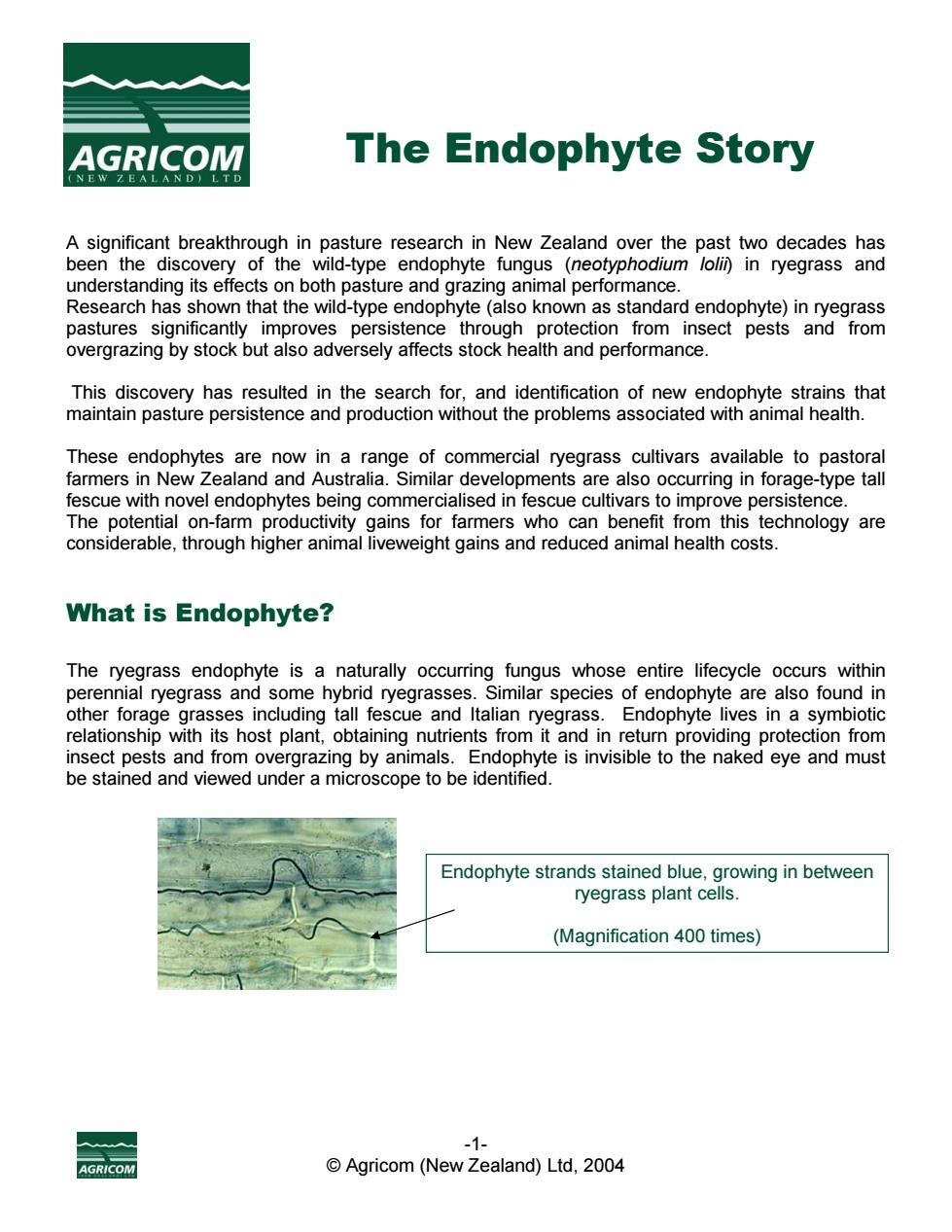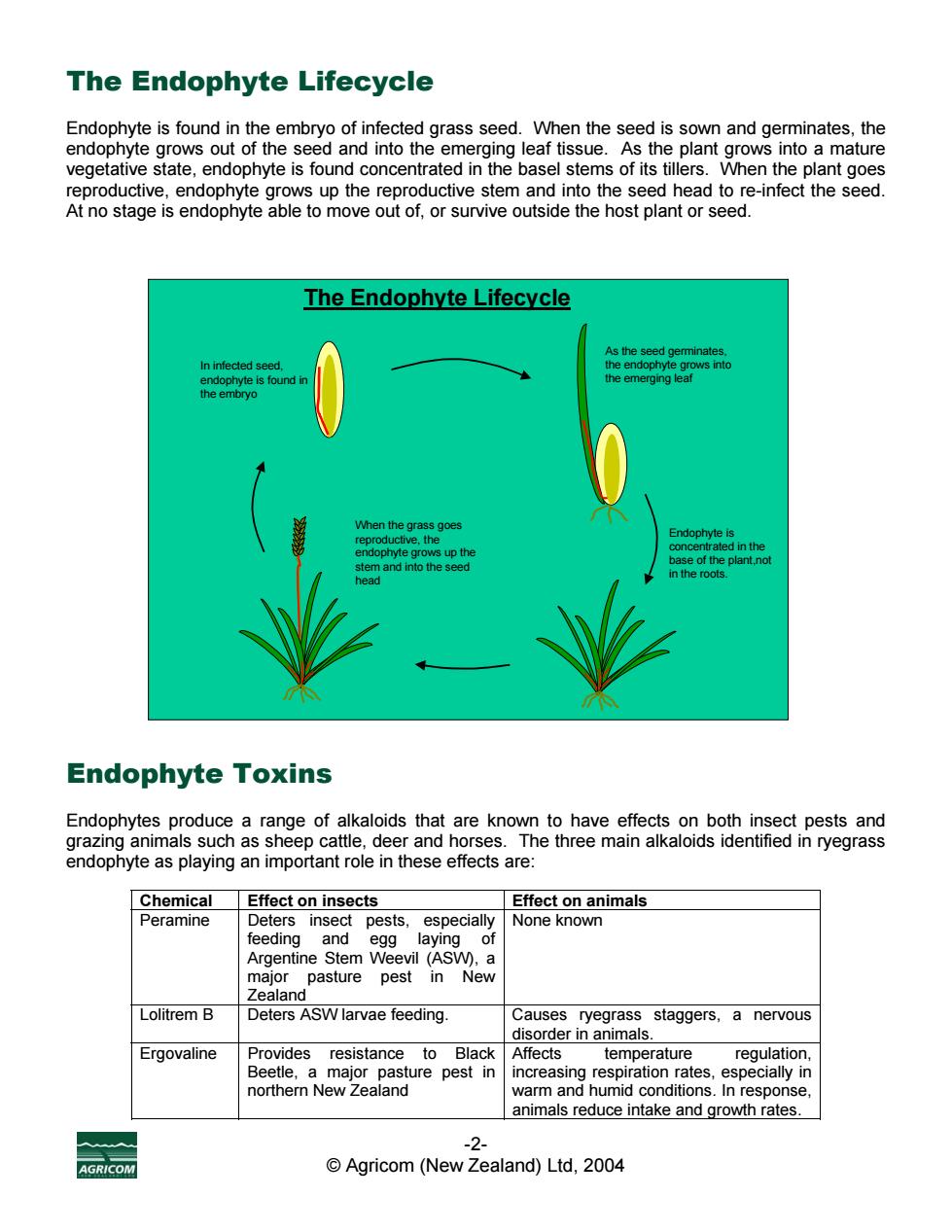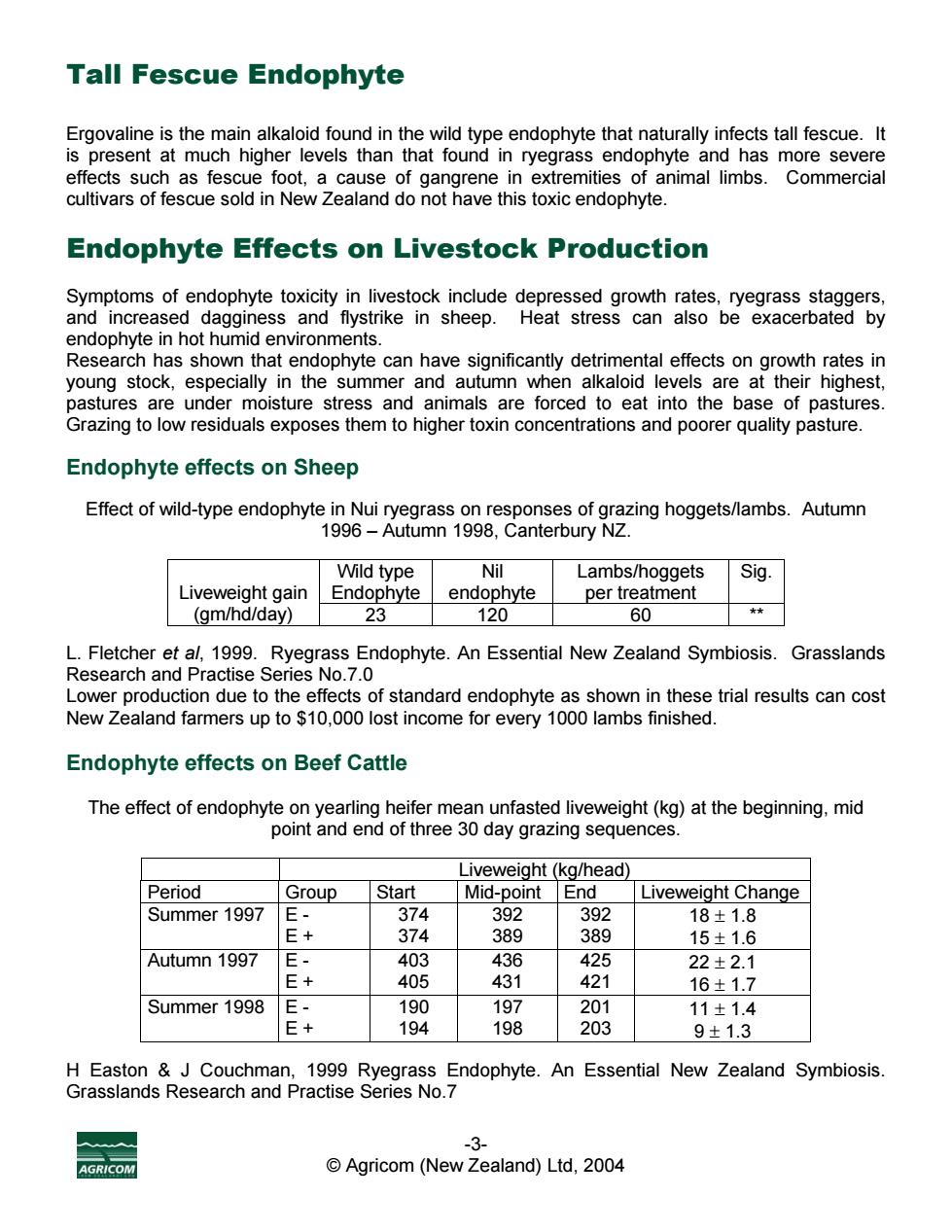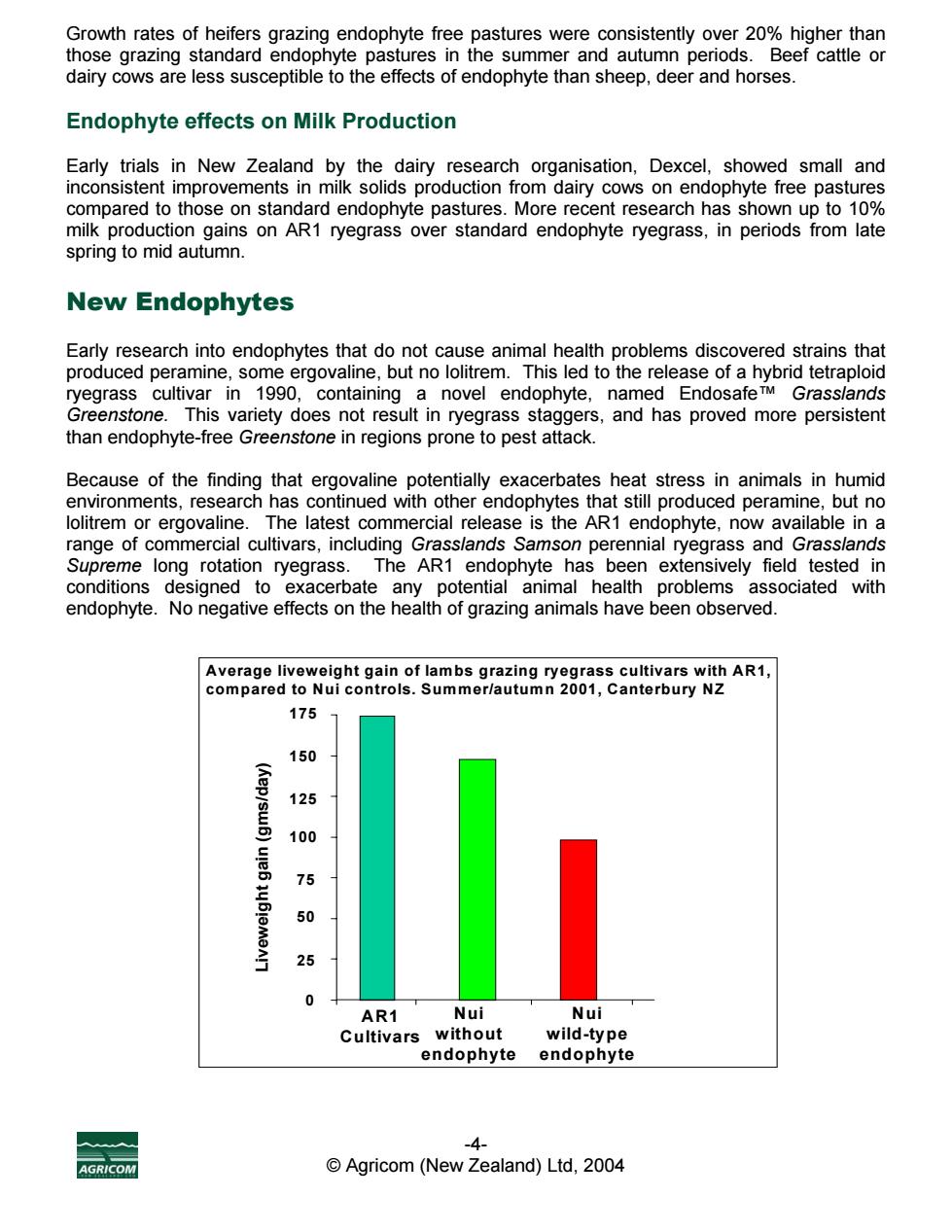
AGRICOM The Endophyte Story A significant breakthrough in pasture research in New Zealand over the past two decades has been the discovery of the wild-type endophyte fungus (neotyphodium loli)in ryegrass and understanding its effects on both pasture and grazing animal performance. Research has shown that the wild-type endophyte(also known as standard endophyte)in ryegrass animal health These en ophytes are now in a range of commercial ryegrass cultivars available to pastora farmers in New Zealand and Australia.Similar developments are also occurring in forage-type tall fescue with novel endophytes being commercialised in fescue cultivars to improve persistence. The potential on-farm productivity gains for farmers who can benefit from this technology are considerable,through higher animal liveweight gains and reduced animal health costs. What is Endophyte? The ryegrass endophyte is a naturally occurring fungus whose entire lifecycle occurs within perennial ryegrass and some hybrid ryegrasses.Similar species of endophyte are also found in other forage grasses including tall fescue and Italian ryegrass.Endophyte lives in a symbiotic relationship with its host plant,obtaining nutrients from it and in retumn providing protection from insect pests and from overgrazing by animals.Endophyte is invisible to the naked eye and must be stained and viewed under a microscope to be identified. Endophyte strands stained blue,growing in between ryegrass plant cells. (Magnification 400 times) 盖 1 Agricom (New Zealand)Ltd.2004
The Endophyte Story A significant breakthrough in pasture research in New Zealand over the past two decades has been the discovery of the wild-type endophyte fungus (neotyphodium lolii) in ryegrass and understanding its effects on both pasture and grazing animal performance. Research has shown that the wild-type endophyte (also known as standard endophyte) in ryegrass pastures significantly improves persistence through protection from insect pests and from overgrazing by stock but also adversely affects stock health and performance. This discovery has resulted in the search for, and identification of new endophyte strains that maintain pasture persistence and production without the problems associated with animal health. These endophytes are now in a range of commercial ryegrass cultivars available to pastoral farmers in New Zealand and Australia. Similar developments are also occurring in forage-type tall fescue with novel endophytes being commercialised in fescue cultivars to improve persistence. The potential on-farm productivity gains for farmers who can benefit from this technology are considerable, through higher animal liveweight gains and reduced animal health costs. What is Endophyte? The ryegrass endophyte is a naturally occurring fungus whose entire lifecycle occurs within perennial ryegrass and some hybrid ryegrasses. Similar species of endophyte are also found in other forage grasses including tall fescue and Italian ryegrass. Endophyte lives in a symbiotic relationship with its host plant, obtaining nutrients from it and in return providing protection from insect pests and from overgrazing by animals. Endophyte is invisible to the naked eye and must be stained and viewed under a microscope to be identified. Endophyte strands stained blue, growing in between ryegrass plant cells. (Magnification 400 times) -1- © Agricom (New Zealand) Ltd, 2004

The Endophyte Lifecycle a leaf tissue As the nlant arows into a mature vegetative state.endophvte is found concentrated in the basel stems of its tillers.When the plant goes reproductive,endophyte grows up the reproductive stem and into the seed head to re-infect the seed. At no stage is endophyte able to move out of.or survive outside the host plant or seed. The Endophyte Lifecycle e in the roots Endophyte Toxins Endophytes produce a range of alkaloids that are knov to have on both in sect pests and ing animal sheep The three main alkaloi identified in ryegrass Chemical Effect on insects Effect on animals Peramine Deters insect pests,especially None known feeding and egg laying 0 Argentine S Lolitrem B Deters ASW larvae feeding. Causes ryegrass staggers,a nervous disorder in animals. Ergovaline Provides regulation naNmo3Pa ea ng resp tes,espes ally in animals reduce intake and growth rates. 0 Agricom(New Zealand)Ltd,2004
The Endophyte Lifecycle Endophyte is found in the embryo of infected grass seed. When the seed is sown and germinates, the endophyte grows out of the seed and into the emerging leaf tissue. As the plant grows into a mature vegetative state, endophyte is found concentrated in the basel stems of its tillers. When the plant goes reproductive, endophyte grows up the reproductive stem and into the seed head to re-infect the seed. At no stage is endophyte able to move out of, or survive outside the host plant or seed. In infected seed, endophyte is found in the embryo As the seed germinates, the endophyte grows into the emerging leaf Endophyte is concentrated in the base of the plant,not in the roots. When the grass goes reproductive, the endophyte grows up the stem and into the seed head The Endophyte Lifecycle Endophyte Toxins Endophytes produce a range of alkaloids that are known to have effects on both insect pests and grazing animals such as sheep cattle, deer and horses. The three main alkaloids identified in ryegrass endophyte as playing an important role in these effects are: Chemical Effect on insects Effect on animals Peramine Deters insect pests, especially feeding and egg laying of Argentine Stem Weevil (ASW), a major pasture pest in New Zealand None known Lolitrem B Deters ASW larvae feeding. Causes ryegrass staggers, a nervous disorder in animals. Ergovaline Provides resistance to Black Beetle, a major pasture pest in northern New Zealand Affects temperature regulation, increasing respiration rates, especially in warm and humid conditions. In response, animals reduce intake and growth rates. -2- © Agricom (New Zealand) Ltd, 2004

Tall Fescue Endophyte Ergovaline is the main alkaloid found in the wild type endophyte that naturally infects tall fescue.It is present at much higher levels than that found in ryegrass endophyte and has more severe effects such as fescue foot,a cause of gangrene in extremities of animal limbs. Commercial cultivars of fescue sold in New Zealand do not have this toxic endophyte. Endophyte Effects on Livestock Production Symptoms of endophyte toxicity in livestock include depressed growth rates,ryegrass staggers and increased dag ess and flystrike in sheep.Heat stress can also be exacerbated by endophvte in hot hum ch hassh thatendohyte can have sinificanty detrimental effects on grow ratesin especial in the ummer and autu nn wh n alkaloid levels are their hiahest res a oisture are forced to the f pastu res Endophyte effects on Sheep Effect of wild-type endophyte Auturss oresponses or gvazing noggets/ambs.Autumn Wild type Nil Sig. Livew eight gain End yte Laeee per tre (gm/hd/day) 23 nyte 120 60 Research and Prac cts of standard endophyte as shown in th se trial results can cos ealand farmers up to $10,000 lost income for every 1000 lambs finishe Endophyte effects on Beef Cattle The effect of endophyte on yearling heifer mean unfasted liveweight(kg)at the beginning,mid point and end of three 30 day grazing sequences Liveweight(kg/head) Period Group I Start Mid-point I End Liveweight Change Summer 1997 374 207 202 E+ 374 389 389 15±1.6 Autumn 1997 E 40: 436 425 22±2.1 + 405 431 421 16±1.7 Summer 1998 E- 190 197 01 11+14 F+ 194 198 203 9±1.3 ries No.7 3- Agricom(New Zealand)Ltd,2004
Tall Fescue Endophyte Ergovaline is the main alkaloid found in the wild type endophyte that naturally infects tall fescue. It is present at much higher levels than that found in ryegrass endophyte and has more severe effects such as fescue foot, a cause of gangrene in extremities of animal limbs. Commercial cultivars of fescue sold in New Zealand do not have this toxic endophyte. Endophyte Effects on Livestock Production Symptoms of endophyte toxicity in livestock include depressed growth rates, ryegrass staggers, and increased dagginess and flystrike in sheep. Heat stress can also be exacerbated by endophyte in hot humid environments. Research has shown that endophyte can have significantly detrimental effects on growth rates in young stock, especially in the summer and autumn when alkaloid levels are at their highest, pastures are under moisture stress and animals are forced to eat into the base of pastures. Grazing to low residuals exposes them to higher toxin concentrations and poorer quality pasture. Endophyte effects on Sheep Effect of wild-type endophyte in Nui ryegrass on responses of grazing hoggets/lambs. Autumn 1996 – Autumn 1998, Canterbury NZ. Wild type Endophyte Nil endophyte Lambs/hoggets per treatment Sig. Liveweight gain (gm/hd/day) 23 120 60 ** L. Fletcher et al, 1999. Ryegrass Endophyte. An Essential New Zealand Symbiosis. Grasslands Research and Practise Series No.7.0 Lower production due to the effects of standard endophyte as shown in these trial results can cost New Zealand farmers up to $10,000 lost income for every 1000 lambs finished. Endophyte effects on Beef Cattle The effect of endophyte on yearling heifer mean unfasted liveweight (kg) at the beginning, mid point and end of three 30 day grazing sequences. Liveweight (kg/head) Period Group Start Mid-point End Liveweight Change Summer 1997 E - E + 374 374 392 389 392 389 18 ± 1.8 15 ± 1.6 Autumn 1997 E - E + 403 405 436 431 425 421 22 ± 2.1 16 ± 1.7 Summer 1998 E - E + 190 194 197 198 201 203 11 ± 1.4 9 ± 1.3 H Easton & J Couchman, 1999 Ryegrass Endophyte. An Essential New Zealand Symbiosis. Grasslands Research and Practise Series No.7 -3- © Agricom (New Zealand) Ltd, 2004

Growth rates of heifers those s gra do Beef cattle or Endophyte effects on Milk Production Early trials in New Zealand by the dairy research organisation,Dexcel,showed small and inconsistent improvements in milk solids production from dairy cows on endophyte free pastures compared to those on standard endophyte pastures.More recent research has shown up to 10% milk production gains on AR1 ryegrass over standard endophyte ryegrass,in periods from late spring to mid autumn. New Endophytes Early research into endophytes that do not cause animal health problems dis overed strains tha produced peramine,some ergovaline,but no lolitrem. Ihis le ryegrass cultivar in 1990 a novel endophyte, Grasslands Greenstone. This variety does not result in ryegrass staggers,and has proved more persistent than endophyte-free Greenstone in regions prone to pest attack. Because of the finding that ergovaline potentially exacerbates heat stress in animals in humid environments,research has continued with other endophytes that still produced peramine,but no lolitrem or ergovaline.The latest commercial release is the AR1 endophyte,now available in a range of commercial cultivars,including Grasslands Samson perennial ryegrass and Grasslands Supreme long rotation ryegrass.The AR1 endophyte has been extensively field tested in conditions designed to any potential animal health problems associated with endophyte.No negative effects on the health of grazing animals have been observed. 175 150 12s 100 75 0 AR1 Nui Nui Cultivars without wild-type endophyte endophyte y Agricom(New Zealand)Ltd,2004
Growth rates of heifers grazing endophyte free pastures were consistently over 20% higher than those grazing standard endophyte pastures in the summer and autumn periods. Beef cattle or dairy cows are less susceptible to the effects of endophyte than sheep, deer and horses. Endophyte effects on Milk Production Early trials in New Zealand by the dairy research organisation, Dexcel, showed small and inconsistent improvements in milk solids production from dairy cows on endophyte free pastures compared to those on standard endophyte pastures. More recent research has shown up to 10% milk production gains on AR1 ryegrass over standard endophyte ryegrass, in periods from late spring to mid autumn. New Endophytes Early research into endophytes that do not cause animal health problems discovered strains that produced peramine, some ergovaline, but no lolitrem. This led to the release of a hybrid tetraploid ryegrass cultivar in 1990, containing a novel endophyte, named Endosafe™ Grasslands Greenstone. This variety does not result in ryegrass staggers, and has proved more persistent than endophyte-free Greenstone in regions prone to pest attack. Because of the finding that ergovaline potentially exacerbates heat stress in animals in humid environments, research has continued with other endophytes that still produced peramine, but no lolitrem or ergovaline. The latest commercial release is the AR1 endophyte, now available in a range of commercial cultivars, including Grasslands Samson perennial ryegrass and Grasslands Supreme long rotation ryegrass. The AR1 endophyte has been extensively field tested in conditions designed to exacerbate any potential animal health problems associated with endophyte. No negative effects on the health of grazing animals have been observed. 0 100 150 Nui without endophyte Nui wild-type endophyte Liveweight g ain (gms/da y) 175 125 75 50 25 Average liveweight gain of lambs grazing ryegrass cultivars with AR1, compared to Nui controls. Summer/autumn 2001, Canterbury NZ AR1 Cultivars -4- © Agricom (New Zealand) Ltd, 2004

Farmers can now choose between a range of endophyte options in ryegrass varieties to best suit their climatic and animal production requirements. Tall Fescue Endophytes In southeastern states of the USA,there are more than 15 million hectares of tall fescue grown as cool-season perennial pastures. The varieties used in the United States often cause heat stress in animals during the summer due us that is similar to the wild-type ryegrass endophyte. This endophyte is important for the pasture The successful r es earch progra e that ider ntified non-toxic rye endophyte t es to help rye ss staggers he Unic ch in N a ersity c Georgla and tes has resulte d in the development of a non-toxic endophyte strain for tall fescue. known as Max Q With co mmercial investment by two NZ seed companies,Agricom New Zealand Ltd and Wrightsor Seeds Ltd,Max Q is now available in a range of tall fescue varieties to alleviate grazing livestock problems in US pastures. The domesticated tall fescue varieties sown in New Zealand and Australia have always been free of endophyte so have never caused animal health problems. However,local research has shown that the introduction of novel endophyte into tall fescue lines consistently improves the performance of the species in a number of regions without any adverse effects on grazing animals. 孟 -5- Agricom(New Zealand)Ltd,2004
-5- © Agricom (New Zealand) Ltd, 2004 Farmers can now choose between a range of endophyte options in ryegrass varieties to best suit their climatic and animal production requirements. Tall Fescue Endophytes In southeastern states of the USA, there are more than 15 million hectares of tall fescue grown as cool-season perennial pastures. The varieties used in the United States often cause heat stress in animals during the summer due to an endophyte fungus that is similar to the wild-type ryegrass endophyte. This endophyte is important for the persistence of tall fescue pastures. The successful research programme that identified non-toxic ryegrass endophyte types to help managing ryegrass staggers and heat stress has also been applied to tall fescue. Collaborative research by AgResearch in New Zealand and the University of Georgia and Pennington Seed Inc in the United States has resulted in the development of a non-toxic endophyte strain for tall fescue, known as Max Q. With commercial investment by two NZ seed companies, Agricom New Zealand Ltd and Wrightson Seeds Ltd, Max Q is now available in a range of tall fescue varieties to alleviate grazing livestock problems in US pastures. The domesticated tall fescue varieties sown in New Zealand and Australia have always been free of endophyte so have never caused animal health problems. However, local research has shown that the introduction of novel endophyte into tall fescue lines consistently improves the performance of the species in a number of regions without any adverse effects on grazing animals